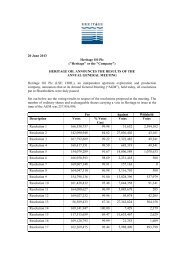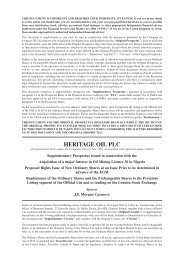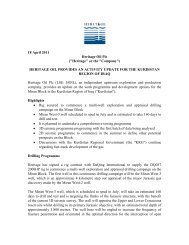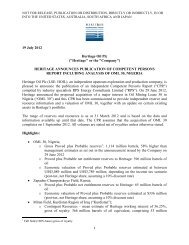Prospectus re Admission to the Official List - Heritage Oil
Prospectus re Admission to the Official List - Heritage Oil
Prospectus re Admission to the Official List - Heritage Oil
Create successful ePaper yourself
Turn your PDF publications into a flip-book with our unique Google optimized e-Paper software.
iii) IFRIC 12, ‘‘Service concession arrangements’’ (effective from 1 January 2008), applies <strong>to</strong>contractual arrangements whe<strong>re</strong>by a private sec<strong>to</strong>r opera<strong>to</strong>r participates in <strong>the</strong> development,financing, operation and maintenance of infrastructu<strong>re</strong> for public sec<strong>to</strong>r services.iv) IFRIC 13, ‘‘Cus<strong>to</strong>mer loyalty programmes’’ (effective from 1 July 2008), clarifies that whe<strong>re</strong>goods or services a<strong>re</strong> sold <strong>to</strong>ge<strong>the</strong>r with a cus<strong>to</strong>mer loyalty incentive (for example, loyaltypoints or f<strong>re</strong>e products), <strong>the</strong> arrangement is a multiple-element arrangement and <strong>the</strong>consideration <strong>re</strong>ceivable from <strong>the</strong> cus<strong>to</strong>mer is allocated between <strong>the</strong> components of <strong>the</strong>arrangement using fair values.v) IFRIC 14, ‘‘IAS 19—The limit on a defined benefit asset, minimum funding <strong>re</strong>qui<strong>re</strong>mentsand <strong>the</strong>ir interaction’’ (effective from 1 January 2008), provides guidance on assessing <strong>the</strong>limit in IAS 19 on <strong>the</strong> amount of <strong>the</strong> surplus that can be <strong>re</strong>cognised as an asset. It alsoexplains how <strong>the</strong> pension asset or liability may be affected by a statu<strong>to</strong>ry or contractualminimum funding <strong>re</strong>qui<strong>re</strong>ment.The following amendments have been published, but have not been applied in <strong>the</strong>se financialstatements:i) IFRS 2 (Amendment), Sha<strong>re</strong> based payment—Vesting Conditions and Cancellations:effective for accounting periods commencing on or after 1 January 2009;i) IFRS 3 (Amendment) Business Combinations: effective for accounting periods commencingon or after 1 July 2009;iii) IAS 1 (Amendment), P<strong>re</strong>sentation of Financial Statements: effective for accounting periodscommencing on or after 1 January 2009;iv) IAS 23 (Amendment), Borrowing Costs: effective for accounting periods commencing on orafter 1 January 2009;v) IAS 27 (Amendment), Consolidated and Separate Financial Statements: effective foraccounting periods commencing on or after 1 July 2009.The Di<strong>re</strong>c<strong>to</strong>rs do not anticipate that <strong>the</strong> adoption of <strong>the</strong>se amendments will have a materialimpact on <strong>the</strong> Group’s financial statements in <strong>the</strong> period of initial application.2 Risk managementThe Group’s activities expose it <strong>to</strong> a variety of financial risks that arise as a <strong>re</strong>sult of its exploration,development, production, and financing activities. The Group’s overall risk management programmefocuses on <strong>the</strong> unp<strong>re</strong>dictability of financial markets and seeks <strong>to</strong> minimise potential adverse effects on<strong>the</strong> Group’s financial performance.a) Financial risk managementi) Fo<strong>re</strong>ign exchange riskFo<strong>re</strong>ign exchange risk arises when transactions and <strong>re</strong>cognised assets and liabilities of <strong>the</strong>Group entity concerned a<strong>re</strong> denominated in a cur<strong>re</strong>ncy that is not <strong>the</strong> Corporation’sfunctional cur<strong>re</strong>ncy. The Group operates internationally and is exposed <strong>to</strong> fo<strong>re</strong>ign exchangerisk arising from cur<strong>re</strong>ncy exposu<strong>re</strong>s <strong>to</strong> <strong>the</strong> U.S. dollar.The<strong>re</strong> a<strong>re</strong> no forward exchange rate contracts in place at, or subsequent <strong>to</strong>,30 September 2007.At 30 September 2007, if <strong>the</strong> Canadian dollar had st<strong>re</strong>ng<strong>the</strong>ned/weakened by 10% against<strong>the</strong> U.S. dollar with all o<strong>the</strong>r variables held constant, <strong>the</strong> loss for <strong>the</strong> period would have been$2,033,068 (30 September 2006—$99,367; 31 December 2006—$125,982; 31 December2005—$(20,937)) higher/(lower), mainly as a <strong>re</strong>sult of fo<strong>re</strong>ign exchange gains/losses ontranslation of Canadian dollar-denominated general and administrative expenses and cash inbank. Profit is mo<strong>re</strong>/less sensitive <strong>to</strong> movement of Canadian/U.S. dollar exchange rates in2007 than 2006 because of significantly higher general and administrative expenses in 2007 incomparison with 2006.At 30 September 2007, if <strong>the</strong> Russian rouble had st<strong>re</strong>ng<strong>the</strong>ned/weakened by 10% against <strong>the</strong>US dollar with all o<strong>the</strong>r variables held constant, <strong>the</strong> loss for <strong>the</strong> period would have been189















